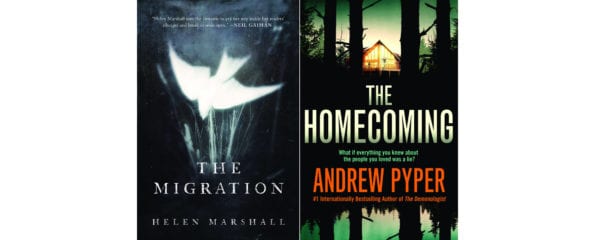
Family bonds are among the strongest and most enduring in the human experience. Blood relations, certainly – mother, father, siblings – but also those among chosen families that consist of spouses and adopted children or non-traditional family units. It is no surprise that humans who develop close working relationships with a small cadre of others refer to their colleagues as being “like a family.” It is equally unsurprising that negative experiences within a family unit can have lifelong deleterious effects on the individuals involved.
Two new novels from established genre writers explore the shifting nature of these attachments in the context of stories that apply powerful stress tests to their durability and longevity. The Migration, by World Fantasy Award winner Helen Marshall, and The Homecoming, by bestselling novelist Andrew Pyper, both have siblings as their beating hearts, and both examine familial relationships through the prism of horror.
Of the two, Marshall’s novel is the stranger and more esoteric. This should come as no surprise to readers familiar with her story collections Hair Side, Flesh Side and Gifts for the One Who Comes After, which contain tales incorporating aspects of fable, dark fantasy, and myth. In her debut novel, Marshall adapts these elements to a narrative that simultaneously flirts with dystopia and reckons with mortality.
The sisters who serve as the story’s main drivers are 17-year-old Sophie Perella and her preteen sibling, Kira. After Kira is diagnosed with juvenile idiopathic immunodeficiency syndrome, a global pandemic that affects exclusively young people, the girls’ mother spirits them away from Toronto (and their father, who remains behind) and relocates them to Oxford, U.K., where their Aunt Irene works as a professor studying the history of epidemics, most particularly the Black Plague.
Marshall is painting on a large canvas here and her style is unabashedly baroque: the novel is characterized by a high level of drama, intensity, and movement, including a repeated motif of flooding, raging waters that claim (or threaten to claim) various characters over the course of the narrative. Climate change is a constant background presence, providing a thematic undercurrent as well as a link to the history of disease in previous ages – Aunt Irene points out that the Black Plague was concurrent with a series of alterations to the natural environment in the 14th century. (This element of the novel also teeters on the precipice of cliché: it would be salutary to put a moratorium on any horror novel that includes a portentous announcement along the lines of “There’s a storm coming.”)
Yet at the centre remains Sophie’s resolute determination to do right by her sister. This involves a slowly developing understanding that death – or at least the sort of death that Kira faces – may not be an end but only a kind of transformation. Marshall’s book proves ultimately optimistic about the ability of the human species to adapt to its circumstances.
Another pair of siblings takes the fore in Pyper’s latest novel, which is grounded in a more realistic presentation, notwithstanding the various convolutions and involutions of the plot. The Homecoming starts with a family of four – brother and sister Aaron and Bridge, older sister Franny, and their mother – arriving at a remote estate for the reading of the late patriarch’s will. The family members are startled by the bequeath: a veritable fortune to be split equally among them, on the condition they remain on the isolated estate, absent any contact with the outside world, for 30 days.
Pyper wears his genre influences on his sleeve – The Homecoming incorporates elements of William Castle’s House on Haunted Hill and The Blair Witch Project before heading off on its own path in the final third. Pyper’s prose is efficient, and he is enough of an old genre hand to know precisely where and when to detonate his shock twists and key story reveals for maximum impact. The fact that a number of these plot points make scant sense is only apparent in retrospect; while the narrative is in full throttle, the impulse is simply to keep the pages turning fast enough to kick up sparks.
Indeed, Pyper is such a master at pace that the more high-minded aspects of his novel – notions of personal identity and culpability, class struggle, and racial discord – are easily overlooked. Though the novel cleaves to Aristotelian unities of time, space, and action, there are intimations that outside the compound – which, not incidentally, is located in Seattle, Washington – there is a crisis involving immigration and some kind of martial law. These chimes with ongoing historical events provide background depth but are wisely kept to the level of subtext.
While The Homecoming is less meditative than The Migration, it is likewise well served by the affecting relationship between Aaron and 14-year-old Bridge: the elder brother’s impulse to protect his vulnerable young sister plays off well against Bridge’s resourcefulness and level-headed approach to their predicament. Both books feature absent fathers and mothers who abandon their children at key moments, and it is the evocative pairs of siblings who put the flesh on the bones of their respective narratives.
 Contact us via email
Contact us via email

